"Tarazana" (sic) is the home of Edgar Rice Burroughs, creator of Tarzan
of the Apes. This estate lies some twenty-five miles northwest of
Los Angeles on the Coast Highway to San Francisco. It extends from the
road far back into the hills of the Coast Range where wild cats and mountain
lions still stalk their prey.
The master of "Tarazana" allows no hunting on his estate. Furthermore,
he secured an appointment as a deputy game warden in order that he might
better protect the wild creatures that live on his land.
Two pools in the garden near the house supply clear fresh drinking water
for the wild things. As a result of this care and protection, the grounds
are alive with small animals, quail and other birds. But the mountain lions
and wild cats cannot be tempted to venture so near to civilization.
Mr. Burroughs neither hunts nor fishes. His keen sense of justice prevents
his finding any fun in killing. He would kill for food or in self-defense,
but not for sport. But he gets a keen joy out of hunting with a camera.
Mr. Burroughs is a dreamer to the extent that he dreams his stories
through, but there his dreams end and he puts them down on paper so they
may profit him and others as well. Though congenial and charming in manner.
Mr. Burroughs is a decidedly practical man. Writing is his profession and
he goes about his work in a systematic, businesslike manner. He aims to
work about four hours a day, usually in the forenoon. He is entirely free
of oddities of any kind. Neither is there a grain of conceit in his make-up.
He refuses to admit any claim to greatness. His books are intended only
to furnish clean entertainment to the reading public. If they stimulate
boys to further reading, they have fulfilled their purpose to the satisfaction
of their author. That they have accomplished their mission is proved by
the fact that the Tarzan books have been translated into seventeen foreign
languages.
"Tarzan of the Apes" was at first refused by thirteen book publishers
and was finally purchased by a newspaper syndicate and ran serially in
more than 6,000 small-town newspapers throughout the country. Through these,
it won instant popular favor and the public then demanded the story in
book form.
Mr. Burroughs has never been in Africa, yet his jungle lore is true
to life. It is based on his careful study of many accounts of explorers
and hunters in the African wilds. The habits of the animals are accurately
portrayed, as are also the descriptions of the jungle and its ways. The
tribe of great apes that Mr. Burroughs makes so real to his readers, does
not actually exist. It is an imaginary combination of the cleverness of
the chimpanzee and the strength and physique of the gorilla.
The language of the apes and monkeys was made up by the author. Mr.
Burroughs gave his nomenclature careful study, making each name fit the
creature for which it is the symbol. Thus, Goro, the moon, Bara, the deer,
Manu, the monkey, and all the other terms, soon sound entirely natural.
His famous city of Opar actually exists. It is one of many such ruins
and is rich in legendry. Its inhabitants, the Oparians, however, are entirely
imaginary.
In his earlier years, Mr. Burroughs was an instructor in the Michigan
Military Academy. Here, among other subjects, he taught Geology. This knowledge
he turned to profit later in his re-creation of some of the prehistoric
races of men. For instance, in his "Taraza the Terrible," the author reconstructed
a tribe of the pre-historic Pithecanthropus Erectus, or ape-men with tails,
who walked erect. Also, his knowledge of Geology enabled him to reconstruct
and make live again, many pre-historic beasts such as the Gryf and others.
The Marian stories are much more highly imaginative than is the Tarzan
set. And who can read of the adventures of John Carver (sic) among the
six-limbed green men of Mars, and not thrill and chill to his very marrow!
California's mild winters attracted Mr. Burroughs and his family for
several consecutive years beginning with 1913. Then in 1919, after one
of Chicago's unusually severe winters, the family journeyed to California
with the intention of making it their permanent home.
In the early spring of that year, Mr. Burroughs purchased the estate
which later became known as "Tarzana." This estate was the home of General
Otis, a hero of the War in the Philippines and founder and manager of the
Los Angeles Times until his death. The palatial white stucco residence
crowning one of the hills, was the General's home. It was occupied by the
Burroughs family for several years after their purchase of the land, but
now it has been converted into a country club and is a playground of the
well-to-do. The author's family now occupies a modest bungalow at
the foot of the hill near the highway.
Of all animals, Mr. Burroughs loves horses best. He keeps several mounts
and finds keenest joy in the saddle. Riding is another of the subjects
in which Mr. Burroughs instructed the students at the Michigan Military
Academy, and he was in the cavalry division of the United States Army for
several years thereafter.
But Mr. Burroughs' chief pride is his family. Two sons and a daughter
have just blossomed into maturity.
None are more delighted readers of their father's books than are the
children of the author. When their father first began reading the Tarzan
books aloud to them, the younger son, Jack, fairly live the part of Tarzan.
It was with difficulty that his father and mother could persuade him to
eat cooked meat. He wanted to eat it raw, for did not Tarzan prefer it
so? One day the astonished father saw his son following him across the
yard on all fours with his nose to the ground. "What in the world
are you doing, Jack?" Mr. Burroughs questioned. "Why father," replied
the boy, I M following your scent spoor."
From his childhood, Mr. Burroughs had always dreamed thrilling adventure
stories but it was not until he was thirty-five that he began to
write them down. This was about 1911, and a year later, his stories began
finding their way into print. In 1913 he gave up his position and began
giving his entire time to the profession of writing.
So this kind, congenial, practical man is contributing his bit to the
happiness of the world.


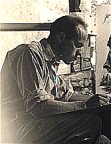
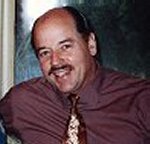
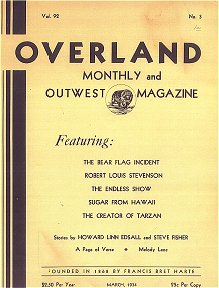
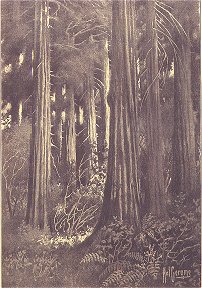
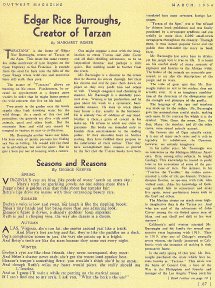
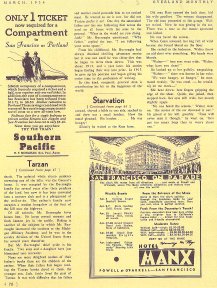
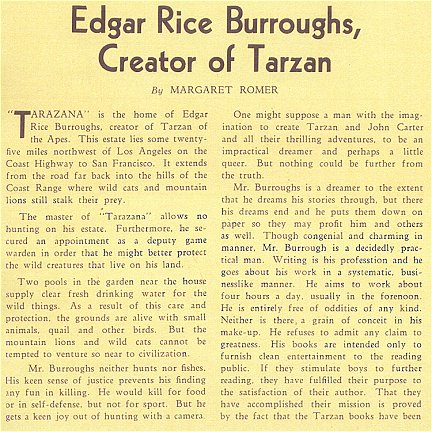

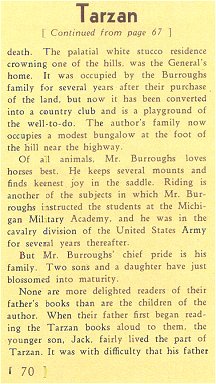
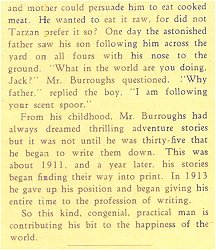
![]()
![]()
![]()
